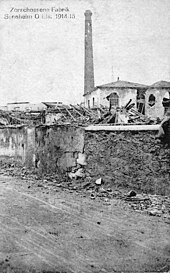Cernay (Haut-Rhin)
| Cernay | ||
|---|---|---|

|
|
|
| region | Grand Est | |
| Department | Haut-Rhin | |
| Arrondissement | Thann-Guebwiller | |
| Canton | Cernay (main town) | |
| Community association | Thann-Cernay | |
| Coordinates | 47 ° 48 ' N , 7 ° 11' E | |
| height | 277-358 m | |
| surface | 18.04 km 2 | |
| Residents | 11,565 (January 1, 2017) | |
| Population density | 641 inhabitants / km 2 | |
| Post Code | 68700 | |
| INSEE code | 68063 | |
| Website | www.ville-cernay.fr | |
 Cernay Town Hall |
||
Cernay (German Sennheim , Alsatian Sanna ) is a French town with 11,565 inhabitants (as of January 1, 2017) in the Haut-Rhin department in the Grand Est region (until 2015 Alsace ). It belongs to the Arrondissement Thann-Guebwiller and is the main town ( French : chef-lieu ) of the canton of Cernay .
location
Cernay is located on the Thur river on the eastern flank of the Vosges . National roads 66 ( Remiremont - Basel ) and 83 ( Lyon - Strasbourg ) cross near Cernay . After Thann (sub-prefecture) in the vicinity of it is six kilometers to Mulhouse 18 and by Belfort 35 km.
Place name
Cernay was first mentioned in 1144 as Sennenheim . This is followed by the names Sennenhem (1156), Senneheim (1179), Sennene (1184), Senene (1191), Senheim (1259), Senhin (1275), Seyreney / Seyrenay (1307/1327), Senhein (1312), Sennen ( 1576). The French name Cernay was coined in the late 17th century with reference to the 1327 documented form Seyrenay , at that time the spelling Sernay was also common. This modern naming was influenced by several other places in France of this name, which go back etymologically to Celtic * (i) sarnāko- "place where there is iron" via Latin Sarnacum . But this is not the etymology of Cernay / Sennheim in Alsace with the oldest form of the name Sennenheim .
history
Mentioned for the first time in 1144, Sennheim was still a mere farm in 1147. In the 13th century, Sennheim developed into a town with a wall (1268), a seal (1292) and a town council, which directed the fortunes of the town under the supervision of the Count von Pfirt . In 1324 Johanna von Pfirt married the Duke of Austria Albrecht II. As a result, the city came to Austria. In 1349 the plague raged . In 1642 King Ludwig XIII. the city to Field Marshal Schönbeck in French service and his heirs as a fief. In the 17th century there was a branch of the Lords von Pfirt in Sennheim . The city received its French name at the end of the 17th century after the conquest by Louis XIV.
The 19th century was characterized by industrialization, especially in the textile sector. In 1860 one of the first workers' settlements of a textile company was built. Like all of Alsace (except Belfort ), Cernay came to the German Empire in 1871 after the Franco-Prussian War , where it remained until 1918. During the First World War , Cernay was on the front line and about 80 percent was destroyed.
After two decades of recovery, German troops again marched into the city on June 17, 1940. From 1940 to 1945, the SS training camp Sennheim of the Waffen-SS was located here in a former home for the mentally ill , in which mainly NCOs from Francophone countries such as the Charlemagne division were trained. During the fighting over the Alsace bridgehead ( Poche de Colmar ), the city was again affected.
| Population development | ||||||||||||
|---|---|---|---|---|---|---|---|---|---|---|---|---|
| year | 1851 | 1900 | 1946 | 1954 | 1962 | 1968 | 1975 | 1982 | 1990 | 1999 | 2007 | 2016 |
| Residents | 3997 | 4833 | 5800 | 6645 | 8372 | 8563 | 9342 | 10208 | 10313 | 10446 | 11118 | 11617 |
Reformed Church ( EPRAL )
Memorials and cemeteries
- Memorial stones,
- Cernay cemetery,
- Cernay Jewish cemetery,
- German war cemetery in Cernay .
See also
literature
- Le Patrimoine des Communes du Haut-Rhin. Flohic Editions, Volume 1, Paris 1998, ISBN 2-84234-036-1 , pp. 138-153.
Web links
Individual evidence
- ^ Sigismund Billing: History and description of Alsace and its inhabitants, Basel 1782, p. 107
- ^ Sigismund Billing: History and description of Alsace and its inhabitants, Basel 1782, p. 107
- ^ Sigismund Billing: History and description of Alsace and its inhabitants, Basel 1782, p. 107
- ↑ Paul Stintzi: Blumenberg and Tattenried in: Alemannisches Institut Freiburg / Breisgau (ed.): Alemannisches Jahrbuch 1964/65 , Konkordia, Bühl (Baden) 1966, p. 164 f.
- ↑ Henri Mounine: Cernay, 40-45. Le SS training camp de Sennheim. Polygone, Ostwald 1999, ISBN 2-913832-00-8 .
- ↑ (fr) Monument aux Morts, Monument commémoratif du 1er RTM, Nécropole nationale, Tombes militaires, Carré militaire
- ↑ (fr) Cimetière in the Base Mérimée of the French Ministry of Culture (French)
- ↑ (fr) Le cimetière juif médiéval et le nouveau cimetière
- ↑ (fr) Cimetière militaire allemand in the Base Mérimée of the French Ministry of Culture (French)







